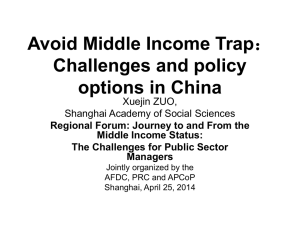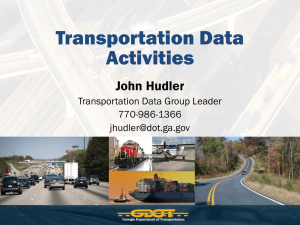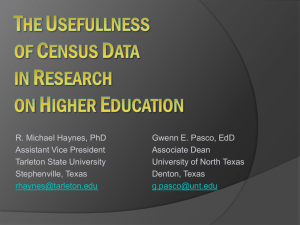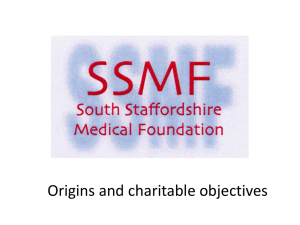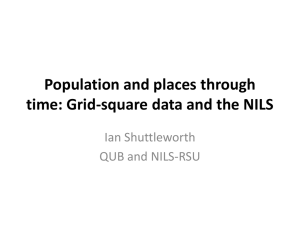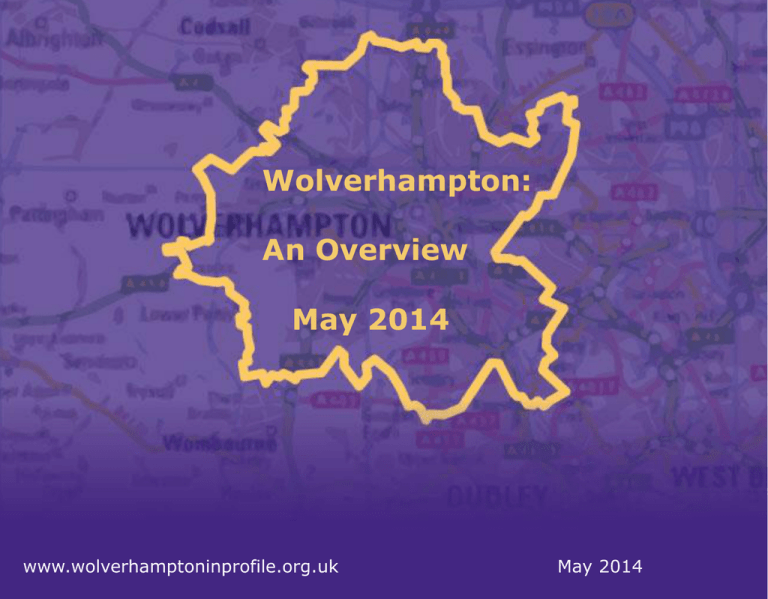
Wolverhampton:
An Overview
May 2014
www.wolverhamptoninprofile.org.uk
May 2014
Wolverhampton in brief
• Situated to the west of Birmingham,
Wolverhampton is one of the 4 local authorities in
the Black Country sub-region (see map)
• Documented history dating back to 985 AD
• Centre of woollen trade in 14th and 15th centuries
• Rapid growth in the 19th century based on coal
and manufacturing industries
• Amongst the most densely populated local
authority areas in England: 249,470 people (2011
Census) living in its 26.8 square miles.
• Over a third of the population are of non-’White
British’ ethnicity (35.5% as of the 2011 Census)
The map shows the location of the Black Country within
Great Britain and is from http://www.bcll.org.uk/
Population trends
• Broadly mirrors UK
population
• Total population: 249,470
• Slow growth model
• Rising older population –
(increased life expectancy)
• Wolverhampton has rising
fertility rates, which is
beginning to increase lower
age bands
• 102,177 households in the
city, 5,055 more households
since 2001, a 5.2% increase
Source: 2011 Census
Total population (2011)
• The total population
rose from 236,582 in
2001 to 249,470 in
2011, a 5.5% rise
• The greatest numbers
of people are usually
found in the inner city,
the north-east, and the
south-east
• The high total
population in some
small areas (LSOAs)
means high population
density, which is
especially marked in
some deprived LSOAs
Source: 2011 Census
Children (0-15) (2011)
• The child population
fell from 49,501 in 2001
to 49,423 in 2011, a
0.15% fall
• St Peter’s, Bushbury
South & Low Hill,
Ettingshall, Fallings
Park, and Heath Town
all have high child
populations
• There are relatively
few children in the west
of the city, especially in
Tettenhall Wightwick,
Tettenhall Regis, and
Park
Source: 2011 Census
Working-age (16-64) (2011)
• The working-age
population rose from
147,096 in 2001 to
159,418 in 2011, a
8.4% rise
• St Peter’s,
Wednesfield South,
Ettingshall, and Heath
Town all have large
working-age
populations
• The working-age
population rising is a
consequence of
changing demographic
trends, and an overall
aging population
Source: 2011 Census
Older people (65+) (2011)
• The older people population
rose from 39,985 in 2001 to
40,629 in 2011, a 1.6% rise
• Tettenhall Regis, Tettenhall
Wightwick, Bushbury North,
Wednesfield North, Merry Hill,
Penn, and Spring Vale all have
large older people populations
• This map is effectively the
opposite of the children map:
areas with many children tend
not to have many older people,
and vice versa
Source: 2011 Census
Ethnicity (2011)
• This map shows the % of
residents who are from BAME
(Black, Asian, Minority Ethnic)
groups in each LSOA. It is everyone
who does not define themselves as
“White British” ethnicity
• BAME residents are primarily
concentrated within the inner city
and the south of the city
• 35.5% of all residents of the city
are classed as BAME
• In one small area (LSOA) in
Wednesfield North, 5.0% of
residents were BAME, compared to
86.1% in one LSOA in Blakenhall
Source: 2011 Census
Religion (2011)
Decline in Christianity since 2001
(10 percentage-point decrease),
increase in ‘no religion’ (from 11%
to 20%), other groups tend to be
static or show slight increases
• 55.5 % Christian
• 9.1 % Sikh
• 3.7 % Hindu
• 3.6% Muslim
• 0.4 % Buddhist
• 1.2 % Other religions
• 20.0% No religion
• 6.4% Not stated
Source: 2011 Census
Disability (2011
& 10/11 to 12/13 academic years)
% of age
Both
& sex
Sexes
Male
Female
0-15
4.3
5.0
3.5
16-49
10.3
10.1
10.5
50-64
30.0
28.0
31.9
65+
60.7
56.8
63.8
All people
20.5
18.8
22.2
51,258 residents (20.5%) who are “limited”
in their day-to-day activities
•
Fewer statemented Special Educational
Needs (SEN) children in 12/13
academic year than 11/12 - still up on
10/11 totals.
SEN
children with
a statement
10/11
11/12
12/13
1,374
1,492
1,417
Sources: 2011 Census / Wolverhampton City Council SEN data
% of residents per social
grade by ward (2011)
Working-age residents (16-64) who are:
AB (Higher (A) and intermediate (B)
managerial - administrative professional)
C1 (Supervisory - clerical - junior
managerial - administrative professional)
C2 (Skilled manual)
D (Semi-skilled & unskilled manual)
E (State benefit, & lowest grade workers)
HIGHEST
ABC1 is Tettenhall Wightwick (65.1%)
C2DE is Bushbury S. & Low Hill (73.2%)
Source: 2011 Census
Qualifications (2013)
Source: Annual Population Survey
% of working-age residents (aged 16-64)
qualified at NVQ 4 equivalent and
above: e.g. HND, Degree and Higher
Degree level qualifications or equivalent,
and those who have no qualifications
Unemployment (Mar 2014)
• The recession has caused a
significant increase in the number
of people receiving key out-ofwork benefits in Wolverhampton
(27,540 total in August 2013, the
latest available)
• Jobseekers Allowance (JSA)
claimants in particular has risen
greatly since the beginning of
2008, prior to the recession
• As of March 2014, 6.5% of the
city’s population claim JSA (West
Mids 3.6%; Great Britain 2.9%),
which is one of the highest rates
nationally
Source: Office for National
Statistics NOMIS Profile
Deprivation (2010)
• Ranked in the Indices of Deprivation
2010 as the 20th most deprived
nationally, next version due 2015
• Relatively more deprived local authority
(LA) than in 2007 (28th), and is one of the
10% most deprived in England
• The city has several severe pockets of
deprivation, mostly concentrated around
the north, centre, and south-east
• 2 small areas ranked in the 1% most
deprived in England, and 22 small areas
in the 10% most deprived in England
• As of the 2011 Census, 53% of our
population live in small areas within the
top 20% most deprived in England
Source: Department for Communities
& Local Government (DCLG)
Population Projections (1)
• Interim 2011-Based Sub-National Population
Projections (SNPP) estimate the city’s population will be
260,200 by 2021, a 4.1% rise from their baseline 2011
figure – new projected figures expected in June 2014
• The balance of the population will change: an increase
in the number of children, but fewer working-age people,
and more older people
• Slightly increasing birth rates, and inflow of migration
greater than outflow, are important aspects of population
growth, but decreasing mortality rates and longer life
expectancies point to a steadily aging population overall
• The chart overleaf shows population change by 5-year
age band, detailing which groups are projected to rise
and fall over the 10-year period
Population Projections (2)
Population Projections (3)
• 45,400 residents aged 65+ by 2021, an 11.3% increase
in the size of that group between 2011 and 2021. As a
consequence, there will be 7,700 total residents classified
as being in the ‘oldest old’ according to the ONS (aged
85+), a group that often require specialist healthcare
• Any specialist healthcare provision attached to gender
(e.g. male / female only wards, prostate clinics…) will be
influenced by shifting demographics. Housing provision
will also need to adapt to the possible demand for older
couples / lone males accommodation
• Men are living longer than before, possibly increasing
the number of older couples. The aging population,
however, may also be likely to provide support to one
another, lessening need for intervention in some cases
For more information…
Policy Team
Office of the Chief Executive
Wolverhampton City Council
You can call Polly Sharma (01902 550567),
Policy & Equalities Manager, or email
population.statistics@wolverhampton.gov.uk
www.wolverhamptoninprofile.org.uk



